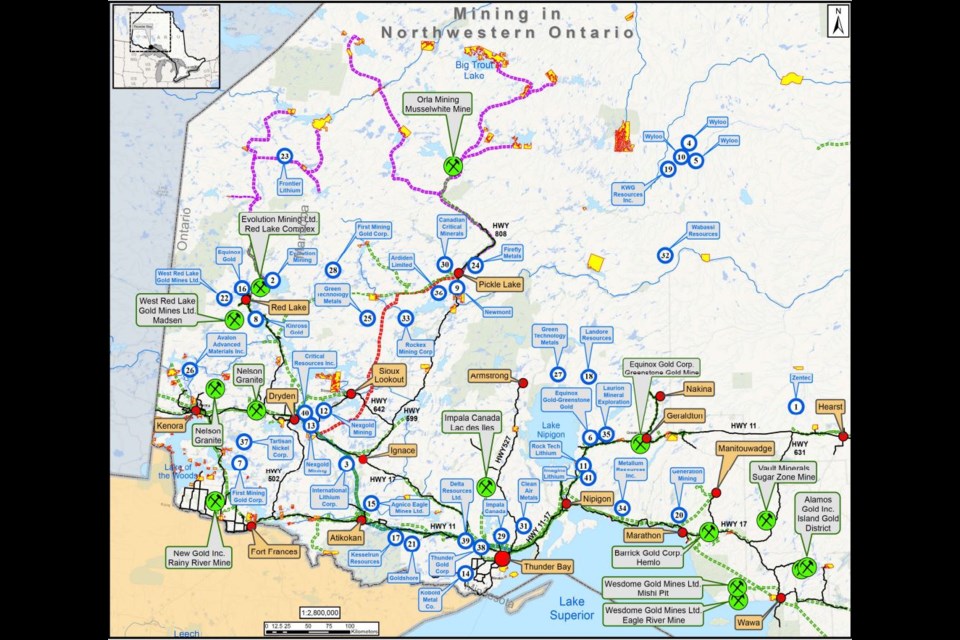THUNDER BAY — Northwestern Ontario would need 250 megawatts of additional energy to meet the demand for the 41 potential mines that are expected to start by 2033, according to the Northwest Energy Task Force.
Iain Angus, co-chair of the lobby group, said Northwestern Ontario could risk losing investments from some of those mining companies if we are “not prepared to provide the power.”
Ontario needs to start building additional transmission lines now, said Angus.
The Northwest Energy Task Force is calling on all provincial candidates in the northwest to seriously consider adding the region's energy needs to their platforms.
“Transmission lines take about 7 years when you go through all the regulatory process and route selection, environmental assessment, things like that, so if you don't start now, you're not gonna meet the deadline,” said Angus.
“We did a study a number of years ago that said when a mine is halfway through its feasibility study, you have to start building the transmission line, but you can't because you don't have the proof that you're gonna go ahead. So, it's a chicken and egg kind of thing.
“We feel strongly that if we invest in the transmission lines now, they'll be there for the mines when they're ready, and that'll be an incentive for the mines to actually happen."
Angus said the baseload, or minimum level of demand, for electricity in the region is 484 megawatts but if each of these mines were to come online today, the region would require 1,968 megawatts of energy.
Currently, the region generates 430 megawatts and can bring up another 650 megawatts from the northeast, he said. And in the short term, approximately 600 megawatts of new load energy could be provided to the Northwest.
However, Angus said the region would still need to generate 288 megawatts to meet the demand of all 41 potential mines.
The Wassigan bulk transmission line was designed with a twin circuit to carry 350 megawatts of power between Shuniah and Atikokan.
Then it will continue from Atikokan to Dryden on a single circuit with a 175 megawatt capacity.
“We estimate that there are 15 new mines planning on coming on stream by 2033, and they will require 550 megawatts of power that is not there now,” said Angus.
Angus noted that Hydro One said they could a double circuit line instead of the single circuit which will upgrade the line to 350, but that is “still not enough to meet the 550 megawatts.”
Greenstone’s radial line, between Geraldton and Nakina, is one of the oldest lines in Canada and suffers from numerous outages leaving residents without power for multiple hours, said Angus.
Recently, the Ontario government and Aroland First Nation announced a $70 million Greenstone Electricity Transmission Line, which would connect First Nations to the Ontario power grid.
Angus said that deal may have come a couple of years too late.
He said that because Ontario could not find a solution to bring additional power to Greenstone, Greenstone Gold had to install six natural gas generators to make up the demand, “which is contrary to Ontario's push to minimize the use of natural gas, fossil fuel, so building transmission lines meets a number of provincial policy strategies.”
Angus said they would like to see the Greenstone Transmission Line completed in two stages: first connecting Geraldton and Nakina to the provincial grind and then extending the line to the Ring of Fire.
The task force estimates that 70 megawatts of power will be needed for four potential mines there.
The Northwest Energy Task Force offers several recommendations to the Ontario government to meet the energy needs of the Northwest.
The task force is also recommending the Independent Electricity System Operator (IESO) to allow the Atikokan Generating Station and Thunder Bay Pulp and Paper to increase their output through their power purchasing agreement.
Within the immediate Thunder Bay area, there are five potential mines and four potential processing plants under consideration, said Angus.
Not every one of the processing plants will become operational, said Angus, but likely one or two will. The task force is anticipating the Thunder Bay area's growth will require up to 365 megawatts.
“We still need to plan for the level of load, and the Thunder Bay CEDC has been working with Synergy North, which is our local utility, Hydro One and the ISO in looking at a solution because we clearly will need some additional power coming into the area,” said Angus.
Additionally, the task force would like to see Little Jack Fish Hydro Electric Generator set as a priority project. The hydroelectric plant could add up to 80 megawatts of power, said Angus.
Moreover, the Northwest Energy Task Force is recommending that the IESO further examine the potential of bioenergy.
Biomass plants take two and a half years to build, according to Angus.
“We’re only using part of our forest. But the part that we're using in terms of logging, between 30 and 40 per cent of what's cut can be used for biomass,” said Angus.
“So, it makes sense to develop a number of new biomass generation facilities throughout the region and create jobs, boost the economy of the smaller communities, and make life a lot easier for a lot of people.
He said that existing sawmills already have the infrastructure in place to build biomass generating plants; however, he also said new plants can be placed in “logical places” where the demand is needed.
